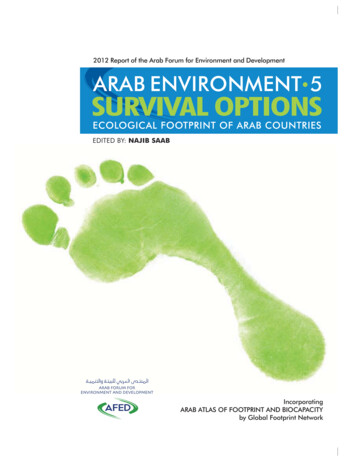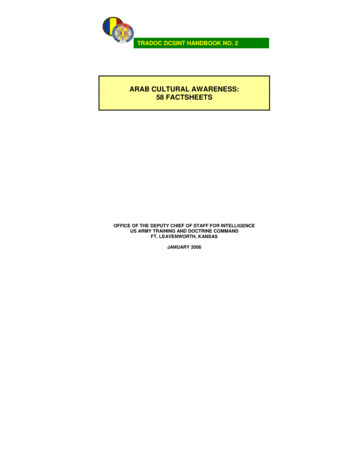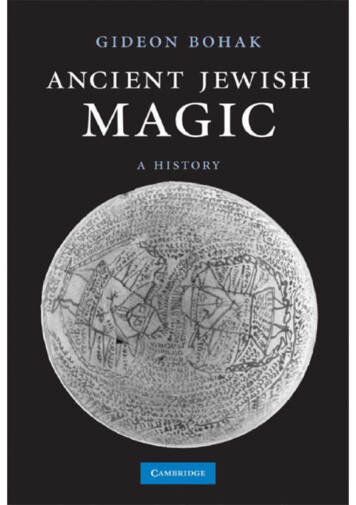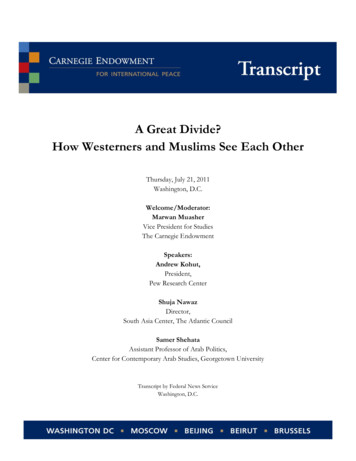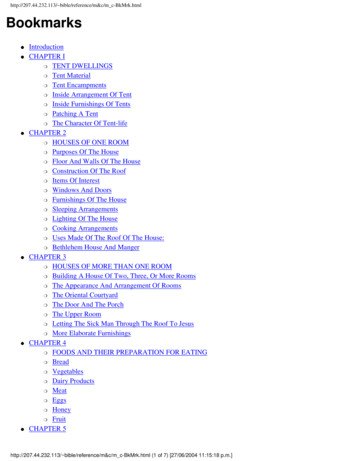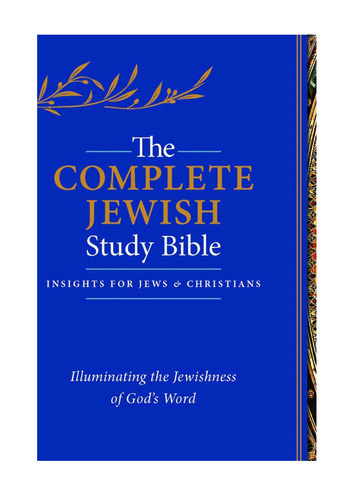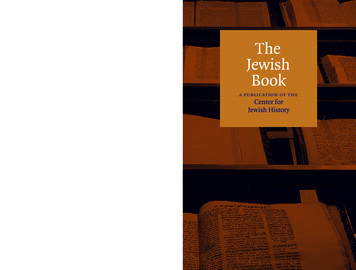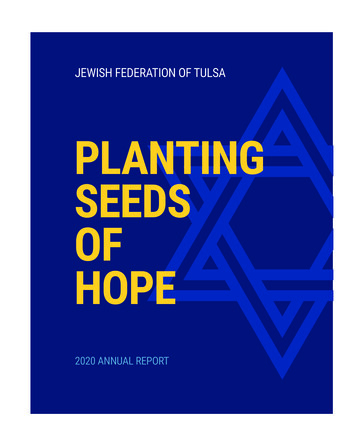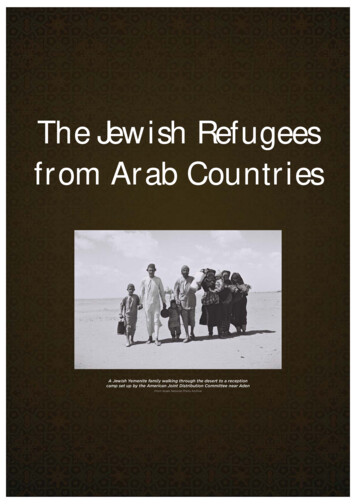
Transcription
The Jewish Refugeesfrom Arab CountriesA Jewish Yemenite family walking through the desert to a receptioncamp set up by the American Joint Distribution Committee near AdenFrom Israeli National Photo Archive
A Cuneiform tablet dating from the Babylonian Exile period attesting to the antiquity ofthe Jewish community in Iraq. The tablet contains numerous Jewish names, and recordsa heifer lease agreement between Haggai son of Ahiqam and Yahu-azar, two brothersfrom the Jewish settlement of Al-Yahudu, southern Iraq, 507 BCECourtesy of the Cindy and David Sofer Collection. Photographer: Ardon Bar-Hama, On display in the exhibition By the Rivers of Babylonat the Bible Lands Museum Jerusalem, 2015-2016History & BackgroundJewish woman in Islamic lands17th century print. From the collection of Beit HatfutsotJewish doctor in Islamic lands17th century print. From the collection of Beit HatfutsotThe Land of Israel was the birthplace of the Jewish People more than threethousand years ago. Since ancient times, centers of Jewish civilizationwere established in many parts of the adjacent regions. Significant Jewishcommunities existed throughout the Middle East, North Africa, Babylon,the Levant, the Arabian Peninsula, Yemen and the Gulf region for more than2000 years, centuries before the advent of Islam and the Arab conquest.
Extent of the Islamic Conquest by 750 CE. Large Jewish communities existed in eachof the designated cities Courtesy of Sir Martin GilbertIslamic ConquestUnder Islamic rule, Jews were considered dhimmi,second-class citizens, forced to pay special taxes, weardistinctive signs and articles of clothing and sufferedother discriminatory decrees and legislation. WhereSharia law was strictly implemented, Jewish orphanswere at times forcibly taken from the community andconverted under coercion.Tomb of the Prophet Ezekiel, Kifil, IraqFrom the collection of Beit HatfutsotTomb of the prophet JonahNorth Mosul, Iraq, Circa 1930Vilnai Collection
Jewish weddingprocession, Debdou,Morocco, Circa 1920From Gerard Levi Jewish PostcardsCollectionReligionMany of the seminal texts of Jewish culture - the Talmud,the major codifications of Jewish law and the siddur (prayerbook) - were written and compiled by Jewish scholars livingin what is today the Middle East. Famous Talmudic academiesthrived in the Babylonian cities of Pumbedita and Sura whereSaadia Gaon, the father of Judeo-Arabic philosophical andlegal literature, served as Exhilarch. In Egypt, Maimonidescompleted his famous Mishneh Torah and Guide for thePerplexed. Jews were called the ‘People of the Book’ by theirArab neighbors and their secular scholarship and medicalknowledge were highly regarded by many Muslim leaders,despite periodic restrictions on Jewish religious practice.Synagogue in suburb ofAlgiers, Algeria 1916From the collection of Beit HatfutsotChevra Kadisha burial society, Algeria 1901From the collection of JIMENARitual circumcision,Tunis 1909From the collection of Beit Hatfutsot
Talmud Torah students, Baghdad, Iraq, Circa 1930From Yad Izhak Ben-Zvi, Photo ArchivesEducationUntil the modern era, Jewish – like Arabic education was primarily based on the studyof religious texts. In order to better cope withpogroms and conditions of severe discrimination,the Alliance Israelite Universelle was created in1860 to equip Jews for modernity and enablethem to struggle for equal rights. The Allianceworked to ensure that Jewish children in theMiddle East and North Africa received firstclass education. Many of its graduates attendeduniversities abroad and achieved scholarlydistinction, such as Claude Cohen-Tannoudji andSerge Haroche who won the Nobel Prize in physics.However, with the rise of Arab nationalism in theTwentieth Century, Jews were marginalized andgradually excluded from public life. Quotas onhigher education were introduced in the 1930’sand 1940’s.Student assembly atOtzar Torah school,Casablanca, Morocco,Circa 1930From Yad Izhak Ben-Zvi, Photo ArchivesYeshivat Beit David Classroom, Morocco, Circa 1930From Yad Izhak Ben-Zvi, Photo ArchivesChildren in Purim costumes at the JewishCommunity Center, Algiers, Algeria 1956
SportsHebrew Sport Day, Damascus, Syria 1936From Yad Izhak Ben-Zvi, Photo ArchivesVictor "Young Perez", originally from Tunis, world boxingflyweight champion, 1931From the collection of Beit HatfutsotUnable to join local Arab sports associations,Jews organized their own, such as Maccabi.Some Jews excelled in internationalcompetition, like Alphonse Halimi, a worldbantamweight champion from Algiers,and Zizi Taieb, a swimming and water polochampion in Tunisia. Guido Asher starredon the Egyptian national basketball team,and Tunis born Pierre Darmon was eighthseed in international tennis rank.Maccabi female basketball team, Cairo, Egypt 1943From the Collection of Levana Zamir
While maintaining a separate identity, Jewswere noted contributors to Arabic culturein literature, poetry and music. Ya'qubBilbul, was a pioneer of the Iraqi novel andshort story. Togo Mizrahi, was a renownedEgyptian director, actor, producer andscreenwriter. Saleh al-Kuwaity is consideredby many to be the father of modern Iraqimusic and Dawood Hosni wrote the firstArabic operetta.Cheikh El Afrite Jewish singer, poet, author andcomposer, Tunis 1884.From the collection of Beit HatfutsotCultureJewish orchestra, Iraq 1933From the collection of the Babylonian Jewry HeritageCenter, Or Yehuda, IsraelJewish fiddler, Tunis 1920From the collection of Beit Hatfutsot
When Jews were granted freedoms theyprospered, but when these were curtailed,they suffered crushing poverty. ManyJews in Egypt, Iraq and Aden achievedsuccess in business and commerce, andtheir contributions to the Arab economieswere highly disproportionate to theirnumbers. When they departed, Jewishcommunities were forced to leave behind,or were expropriated of, assets worthmany billions of dollars.Economic lifeSir Heskel Sassoon, Minister of Finance of the Government of Iraq,1920-1925From the collection of Beit HatfutsotShop of Isaac Gabbai in Egypt 1930From the collection of Beit HatfutsotJewish sweets vendor in Syria during First World WarFrom the collection of Beit Hatfutsot
Over the centuries, the position of theJews was frequently precarious. Therewere numerous incidents of massacresand ethnic cleansing, such as thedestruction of the Jewish communitiesin the Arabian peninsula in the SeventhCentury. In Morocco, Libya and AlgeriaJews were forced to live in ghettos ormellahs. In Yemen and Iraq, Jews attimes were forced to choose betweenconversion to Islam or death. Bloodlibels and other false accusations ledto massive rioting; and in the 1930’sand 1940’s, Nazi-inspired massacrestook place against Jews in Libya, Egyptand Algeria and most infamously inBaghdad, known as the Farhud.Herzila Lukal arrested for Zionistactivity, Erbil, Iraq, 1948From the collection of Beit HatfutsotDiscrimination & PogromsFuneral of Shmuel Jorni,a teenager killed in Tunis,June 1952From the collection of Beit HatfutsotJewish home looted inpogrom, Zuwiya, Libya1945From the collection of Levana ZamirBurned synagogue, Aden, 1948From the collection of Yigal Ben Shalom
Drawings of the Abu Qir detention camp, next toAlexandria, where hundreds of Jews were arrestedfor about 18 months, until expulsionFrom the collection of Levana ZamirConfiscation decreeof Hizkiahu IbrahimBasrawi's assets, by theEgyptian authorities,together with assets ofother JewsExpulsion from the Arab worldPrior to the UN Partition Plan, which called for the creation of a Jewish state alongsidean Arab state in Mandatory Palestine, the Political Committee of the Arab Leaguedrafted a law governing the legal status of Jewish residents.It provided that the bank accounts of Jews from Arab League countries were tobe frozen and used to finance resistance to ‘Zionist ambitions in Palestine’; andJews believed to be active Zionists would be interned as political prisoners andtheir assets confiscated. These and other state-sanctioned acts of repression andviolence, precipitated a mass departure of the ancient Jewish communities, oftenin desperate economic circumstances. In total, over 850,000 Jews were forced toleave the Arab countries, in a process of expulsion and exodus which continuedthrough the 1970’s.Operation "Magic Carpet". Jews from Yemen in an airplane on their way to IsraelFrom the collection of Beit Hatfutsot
On May 14, 1948 the State of Israel was proclaimed.Despite attack from six Arab armies dedicated to itsextermination, waves of mass immigration broughthundreds of thousands of Jews to Israel's shores,Holocaust survivors from Europe and nearly theentire Jewish communities of Libya, Yemen and Iraq.The fledgling state, following a protracted war ofindependence, was in hard economic straits, andstruggled to provide housing and jobs for the newimmigrants. Ma'abarot camps of tin shacks and tentsgave temporary shelter; employment was createdand the Hebrew language taught; the educationalsystem was expanded to meet the needs of tensof thousands of children from varied backgrounds.Additional mass immigration took place in the late1950s and early 1960s, from the newly independentcountries of North Africa, Morocco and Tunisia.The human capital - the expertise, talent andfortitude - of the Jews from Arab lands, hascontributed immeasurably to Israel's success,despite decades of conflict in a violent region.Young girl carrying brother through the mud of BeitLid Camp, Winter 1950From Israel National Photo ArchiveYemenite Jews awaiting airlift to Israel, Aden, 1949From Israel National Photo ArchiveMoroccanimmigrant withher children inrefugee tentcamp, Israel,1949From Israel NationalPhoto ArchiveIntegration into Israel
International StatusThe definition of a refugee in international law appliesclearly to the Jews from Arab lands who had “a well-foundedfear of being persecuted for reasons of race or religion”, andthe UN High Commissioners for Refugees have confirmedon several occasions that the UN considered Jews fleeingpersecution in Arab countries as refugees who fall under theUNHCR mandate.In all the relevant international multilateral and bilateralagreements, (UN Resolution 242, Madrid Conference, IsraelEgypt Peace Treaty, Road Map for Peace), ‘refugees’ arereferred to generically, and include the recognition of allMiddle East refugees – Jews and Arabs alike.
Justice and the Search for PeaceRecognizing the rights of the Jews displaced from Arabcountries is a call for truth and reconciliation. For any peaceprocess to be credible and enduring, it must ensure that allbona fide refugees receive equal rights and treatment underinternational law.And yet, the mass violation of the human rights of the Jewsfrom Arab lands, the destruction of their ancient and thrivingcommunities, the expropriation of their assets and properties,and their displacement and expulsions from their lands ofresidence over the millennia have never been adequatelyaddressed by the UN and the international community.Recognizing the rights of the Jews from Arab countries isa call for justice, fairness and the acknowledgement ofhistorical truth in the search for Middle East peace.Jewish populations leaving Arab countries following establishmentof Israel Courtesy of Sir Martin Gilbert
Personal Stories:Maurice Shohet (Iraq)“We had an opportunity to throw a last glance backat the country where we had grown up and lived.Thoughts welled up in my mind about the countrywe were about to leave behind. We had loved Iraqmore than many Iraqis do. I recalled the memoriesof the land of the Tigris and the Euphrates. As in amovie, I saw pictures passing through my mind, ofthe school where I had grown, of the synagogueswhere I prayed, and of the tombs of the prophetswhere I visited.I thought about the descendants of the ancient IraqiJewish Community that dated back to the time ofthe Babylonian Empire, and the end that had befallenthe Jewish community in this Arab country afterthe State of Israel was established. I thought of themiserable Jews on whom Iraq had vented its wrathafter being shamed, when its army shared defeattogether with other Arab armies during the Six DayWar.“
Personal Stories:Regina Bublil Waldman(Libya, 1967)“When the Six Day War broke out between Israel and its Arabneighbors, I was 19 year old. My mother called me at work totell me that thousands of people had taken to the streets riotingand burning Jewish properties. She begged me to find a hidingplace, because it was too dangerous for me to return home.One of the British engineers in the company agreed to hide me inhis home. Incidentally, he was Christian. From my hiding place, Iwatched the fires consume my father’s warehouse. Killing people,rampaging and burning Jewish properties went on for days.Gina Bublil Waldman, 1960, inPurim costumeI lived in hiding for a month before returning home. All Jewswere expelled and their property, including their bank accounts,were expropriated by the government. We were only allowed totake a few suitcases and very little money.The day we left, armed soldiers put us on a truck to escort us“safely” to the airport. Instead, they dumped us on the side ofthe road. We boarded an airport bus, which then stopped inthe middle of the desert. The driver said that there was enginetrouble and the conductor allegedly went to get help and left usalone, once again. I looked to my father for support, but he wasfrozen in horror. I darted off the bus and ran to find help. As I ranmy whole body shook with fear, but anger drove me forward.When I reached the gas station, the conductor was holding thephone. After struggling with him, I snatched the phone out ofhis hand and called the British engineer who had hidden me. Iturned to leave but now, the door was blocked by three men,including the conductor. I was petrified. My throat tightened.My heart was pounding. I forced my way through the door andran back to the bus.Gasoline was everywhere, the driver held a box of matches inhis hand. The plan was to burn the bus with my family in it. Justthen, the British engineer drove up. My family jumped into his carand we sped off to the airport. Upon arrival, the porters refusedto load our luggage and spit on us. Our flight took us to Rome,Italy, where my family still lives."
success in business and commerce, and their contributions to the Arab economies were highly disproportionate to their numbers. When they departed, Jewish communities were forced to leave behind, or were expropriated of, assets worth many billions of dollars. Sir Heskel Sassoon,
